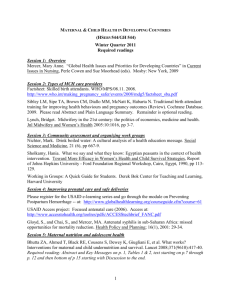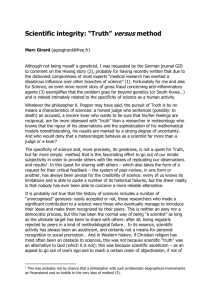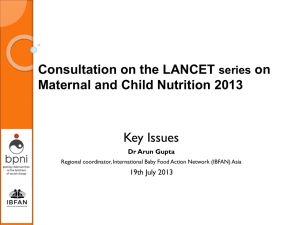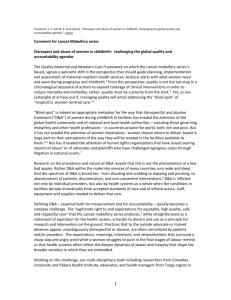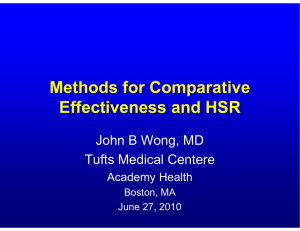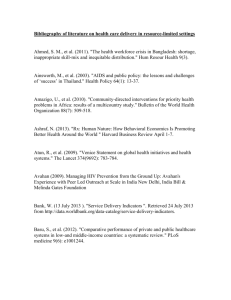College of Public Health & Health Professions PHC 6764 (027E) Syllabus
advertisement
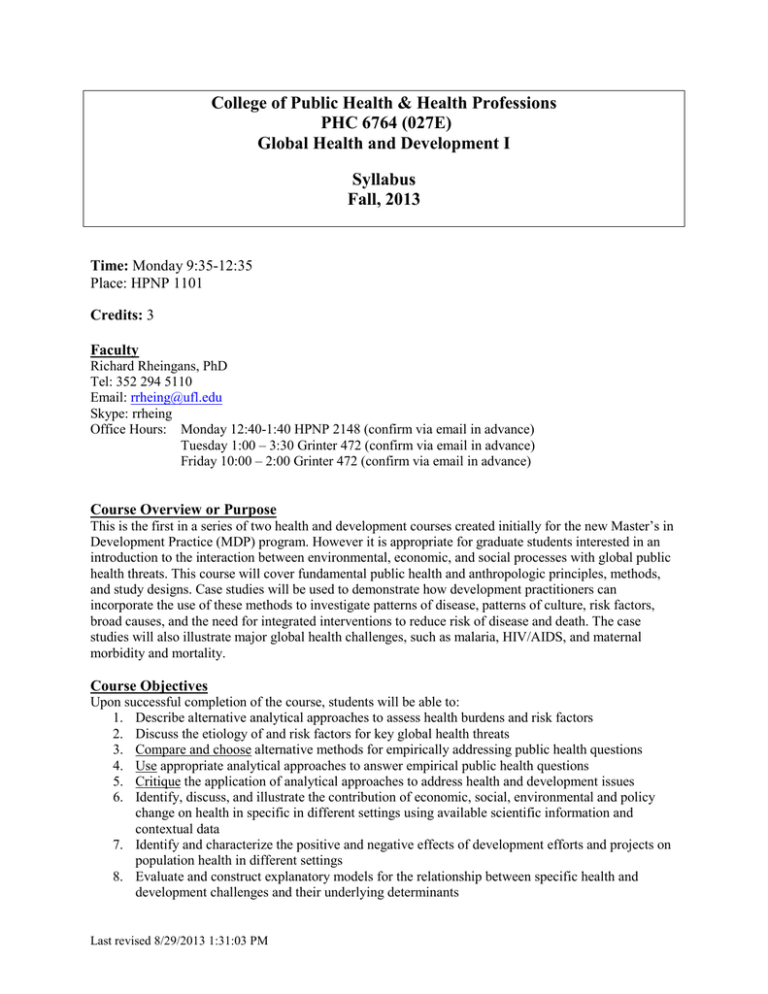
College of Public Health & Health Professions PHC 6764 (027E) Global Health and Development I Syllabus Fall, 2013 Time: Monday 9:35-12:35 Place: HPNP 1101 Credits: 3 Faculty Richard Rheingans, PhD Tel: 352 294 5110 Email: rrheing@ufl.edu Skype: rrheing Office Hours: Monday 12:40-1:40 HPNP 2148 (confirm via email in advance) Tuesday 1:00 – 3:30 Grinter 472 (confirm via email in advance) Friday 10:00 – 2:00 Grinter 472 (confirm via email in advance) Course Overview or Purpose This is the first in a series of two health and development courses created initially for the new Master’s in Development Practice (MDP) program. However it is appropriate for graduate students interested in an introduction to the interaction between environmental, economic, and social processes with global public health threats. This course will cover fundamental public health and anthropologic principles, methods, and study designs. Case studies will be used to demonstrate how development practitioners can incorporate the use of these methods to investigate patterns of disease, patterns of culture, risk factors, broad causes, and the need for integrated interventions to reduce risk of disease and death. The case studies will also illustrate major global health challenges, such as malaria, HIV/AIDS, and maternal morbidity and mortality. Course Objectives Upon successful completion of the course, students will be able to: 1. Describe alternative analytical approaches to assess health burdens and risk factors 2. Discuss the etiology of and risk factors for key global health threats 3. Compare and choose alternative methods for empirically addressing public health questions 4. Use appropriate analytical approaches to answer empirical public health questions 5. Critique the application of analytical approaches to address health and development issues 6. Identify, discuss, and illustrate the contribution of economic, social, environmental and policy change on health in specific in different settings using available scientific information and contextual data 7. Identify and characterize the positive and negative effects of development efforts and projects on population health in different settings 8. Evaluate and construct explanatory models for the relationship between specific health and development challenges and their underlying determinants Last revised 8/29/2013 1:31:03 PM Course Materials Readings will be drawn from current published literature in public health and development. Main background reference: (DCP2) Disease Control Priorities in Developing Countries (2nd Edition), (2006) Jamison DT, Breman JG, Measham AR, Alleyn G, Claeson M, Evans DB, Jha P, Mills A, Musgrove P (Eds). Oxford University Press. (www.dcp2.org) Class participation As a graduate class, all students are expected to attend and actively participate in class. Evaluation Exercises (3 total) Critical questions (5 total) Mid-term exam (take home) Final group project Presentation Written Class participation 20% 15% 25% 10% 25% 5% Exercises. These are short assignments during the early part of the course designed to apply the concepts and skills introduced in the earlier class sessions. Assignments are due before class on the week that they are listed. Critical questions. Students will prepare three critical questions based on the empirical readings for that week’s class (don’t use simple methodological readings for this). Questions should reflect issues that the article raises that you would like to discuss with colleagues. They shouldn’t be factual or testing questions, but instead probing and exploring questions. Be prepared to read your questions in class as a way to build the discussion. Assignments are due before class and must be based on that week’s reading. Mid-term exam. This is designed for you to test your understanding of the basic public health analytical methods, understand their application by others, and apply them to new situations. The exam is NOT a group project and must be completed independently. Final group project. Groups will conduct a situation analysis for a specific country, using primary data from Demographic and Health Surveys, published literature, and reports to assess health threats and identify underlying social, economic, ecological and institutional factors contributing to them. The analysis revolves around each of the health-related challenges addressed in the last part of the course. Students will work in a group to prepare a group presentation and written report. The grade will include an individual component based on peer-assessment. Class participation. Consistent with the spirit of graduate education and the interactive nature of development practice, students are expected to participate fully in every class session. Participation depends upon completing all readings before each class. Last revised 8/29/2013 1:31:03 PM 2 Letter Grade A A- B+ B B- C+ C C D < 65% 65-70% 70-73% 73-77% 77-80% 80-83% 83-87% 87-90% % Earned in class 90-94% 94-100% Grading scale F Translation of letter grades to grade points Letter Grade Grade points A A- B+ B B- C+ C C- D+ D D- E WF I NG S-U 4.0 3.67 3.33 3.0 2.67 2.33 2.0 1.67 1.33 1.0 0.67 0.0 0.0 0.0 0.0 0.0 For greater detail on the meaning of letter grades and university policies related to them, see the Registrar’s Grade Policy regulations: http://www.registrar.ufl.edu/catalog/policies/regulationgrades.html For greater detail on the meaning of letter grades and university policies related to them, see the Registrar’s Grade Policy regulations: http://www.registrar.ufl.edu/catalog/policies/regulationgrades.html Topical Outline Wk Date Topic Reading (* = Required) 1 Aug 26 Introduction / Measuring Health *Murray 2012 *Hyder and Morrow, 2009 *Liu 2012 *Lim 2012 2 Sept 9 Malaria: biology, ecology and populations *DCP2, Ch 21 *Da Silva-Nunez et al., 2008 Baragatti et al 2009 3 4 Sept 16 Sept 23 Dr. Bernard Okech, Department of Environmental and Global Health Quantitative tools for assessing *Ernst et al., 2009 health and development relationships Class meets in Emerging Pathogens Institute – Bring your ID Epidemiology – association and causation Last revised 8/29/2013 1:31:03 PM Assignment Exercise 1 – Due in class *Lee et al., 2012 *Bauman et al., 2012 *Semba et al., 2008 *Coovadia et al., 2007 3 5 Sept 30 Environmental health / Applications to air pollution and water and sanitation 6 Oct 7 Health systems and delivery 7 Oct 14 8 Oct 21 9 Oct 28 Health Behavior and Qualitative Methods Land-use and health / Applications to malaria Nov 4 Exercise 2 – Due in class *Scrimshaw 2009 *Pikora et al., 2003 Vrazel et al, 2008 Weisman and Besser 2004 McMahon et al., 2011 Introduction to final project Health and Development Population change, land use *DCP2, Ch 33 change and health *Anglewic et al., 2012 *Mayosi et al., 2009 Demographic transitions Eisenberg et al., 2012 Migration (“In roads…) Miranda et al, 2008 Applications to chronic *Stevens et al, 2008 diseases and infectious disease *Tollman et al, 2008 *Yang et al, 2008 Health Impact Assessment 10 *Smith et al 1999 *Zhang et al, 2010 *Bartram and Cairncross, 2010 *Eisenberg et al., 2012 DCP2, Ch 42 Hunter et al., 2010 Haines, Smith et al., 2007Smith and Mehta, 2003 Wilkinson et al, 2007 *DCP2, Ch 3 *Grabowsky et al., 2005. *Masive et al., 2010 *Chuma 2007 Ravishankar et al, 2009 Beaglehole et al., 2008 *Chandramohan et al., 2007 Maternal and reproductive Last revised 8/29/2013 1:31:03 PM Exercise 3 – Disease burden due Take home midterm assigned; Due Oct 11 at 5:00 pm Critical questions 1 due *Keiser et al., 2004 *Patz et al, 2008 Kibret et al., 2010 Kittinger et al., 2008 Fegan et al., 2007 Butala et al., 2010 Critical questions 2 due *DCP2, Ch26 Critical questions 4 11 Nov 18 health Filippi et al., 2006 *Jeffrey and Jeffrey, 2010 *Lee-Rife, 2010 *Rosata et al., 2008 Child nutrition *DCP2, Ch 28 *Lloyd et al., 2011 Shelling et al., 2005 Bhutta et al., 2008. Bryce et al., 2008 *Gregson et al., 2001 12 Nov 25 HIV 13 Dec 2 Group Presentations 3 due Critical questions 4 due *DCP2, Ch 18 *Coovadia et al., 2007. *Kidman et al., 2010 Riley and Baah-Odoom, 2010 Country Situation Analysis Readings and References List (Note: Required readings are starred*) *Anglewicz, P., Migration, marital change, and HIV infection in Malawi. Demography, 2012. 49(1): p. 239-65. Arifeen SE, Hoque DM, Akter T, Rahman M, Hoque ME, Begum K, Chowdhury EK, Khan R, Blum LS, Ahmed S, Hossain MA, Siddik A, Begum N, Sadeq-ur Rahman Q, Haque TM, Billah SM, Islam M, Rumi RA, Law E, Al-Helal ZA, Baqui AH, Schellenberg J, Adam T, Moulton LH, Habicht JP, Scherpbier RW, Victora CG, Bryce J, Black RE. 2009. Effect of the Integrated Management of Childhood Illness strategy on childhood mortality and nutrition in a rural area in Bangladesh: a cluster randomized trial. Lancet. Aug 1;374(9687):393-403. Baragatti M, Fournet F, Henry MC, Assi S, Ouedraogo H, Rogier C, Salem G. 2009. Social and environmental malaria risk factors in urban areas of Ouagadougou, Burkina Faso. Malar J. Jan 13;8:13. Bauman AE, Reis RS, Sallis JF, Wells JC, Loos RJ, Martin BW. Correlates of physical activity: why are some people physically active and others not? Lancet 2012 Jul 21;380(9838):258-71. Beaglehole R, Epping-Jordan J, Patel V, Chopra M, Ebrahim S, Kidd M, Haines A. 2008. Improving the prevention and management of chronic disease in low-income and middle-income countries: a priority for primary health care. Lancet. Sep 13;372(9642):940-9. Beaudoin CE, Boris NW, Brown L, Littrell MA, Macintyre KC. 2010.The multilevel effects of bonding and bridging social capital on child and adolescent health and psychosocial outcomes in Malawi. Soc Sci Med. Jun 16. Last revised 8/29/2013 1:31:03 PM 5 Bhutta ZA, Ahmed T, Black RE, Cousens S, Dewey K, Giugliani E, Haider BA, Kirkwood B, Morris SS, Sachdev HP, Shekar M; Maternal and Child Undernutrition Study Group. What works? Interventions for maternal and child undernutrition and survival. Lancet. 2008 Feb 2;371(9610):417-40. Bhutta ZA, Chopra M, Axelson H, Berman P, Boerma T, Bryce J, Bustreo F, CavagneroE, Cometto G, Daelmans B, de Francisco A, Fogstad H, Gupta N, Laski L, Lawn J, Maliqi B, Mason E, Pitt C, Requejo J, Starrs A, Victora CG, Wardlaw T. 2010. Countdown to 2015 decade report (2000-10): taking stock of maternal, newborn, and child survival. Lancet. Jun 5;375(9730):2032-44. Biggs B, King L, Basu S, Stuckler D. 2010. Is wealthier always healthier? The impact of national income level, inequality, and poverty on public health in Latin America. Soc Sci Med. Jul;71(2):266-73. *Black RE, Cousens S, Johnson HL, Lawn JE, Rudan I, Bassani DG, Jha P, Campbell H, Walker CF, Cibulskis R, Eisele T, Liu L, Mathers C; Child Health Epidemiology Reference Group of WHO and UNICEF. 2010. Global, regional, and national causes of child mortality in 2008: a systematic analysis. Lancet. Jun 5;375(9730):1969-87. Black RE, Allen LH, Bhutta ZA, Caulfield LE, de Onis M, Ezzati M, Mathers C, Rivera J; Maternal and Child Undernutrition Study Group. 2008. Maternal and child undernutrition: global and regional exposures and health consequences. Lancet. Jan 19;371(9608):243-60. Blas E, Gilson L, Kelly MP, Labonte R, Lapitan J, Muntaner C, Ostlin P, Popay J, Sadana R, Sen G, Schrecker T, Vaghri Z. 2008. Addressing social determinants of health inequities: what can the state and civil society do? Lancet. Nov 8;372 (9650):1684-9. Bryce J, Coitinho D, Darnton-Hill I, Pelletier D, Pinstrup-Andersen P; Maternal and Child Undernutrition Study Group. 2008. Maternal and child undernutrition: effective action at national level. Lancet. Feb 9;371(9611):510-26. Bryce J, Gilroy K, Jones G, Hazel E, Black RE, Victora CG. 2010. The Accelerated Child Survival and Development programme in west Africa: a retrospective evaluation Lancet. Feb 13;375(9714):57282 Butala NM, VanRooyen MJ, Patel RB. 2010. Improved health outcomes in urban slums through infrastructure upgrading. Soc Sci Med. Sep;71(5):935-40. Chopra M, Daviaud E, Pattinson R, Fonn S, Lawn JE. 2009. Saving the lives of South Africa's mothers, babies, and children: can the health system deliver? Lancet. Sep 5;374(9692):835-46. Chandramohan D, Webster J, Smith L, Awine T, Owusu-Agyei S, Carneiro I. 2007. Is the Expanded Programme on Immunisation the most appropriate delivery system for intermittent preventive treatment of malaria in West Africa? Trop Med Int Health. Jun;12(6):743-50. Chuma J, Gilson L, Molyneux C. 2007. Treatment-seeking behaviour, cost burdens and coping strategies among rural and urban households in Coastal Kenya: an equity analysis. Trop Med Int Health. May;12(5):673-86. Cochrane T, Davey RC. 2008. Increasing uptake of physical activity: a social ecological approach. J R Soc Promot Health. Jan;128(1):31-40. *Coovadia HM, Rollins NC, Bland RM, Little K, Coutsoudis A, Bennish ML, Newell ML. 2007. Motherto-child transmission of HIV-1 infection during exclusive breastfeeding in the first 6 months of life: an intervention cohort study. Lancet. Mar 31;369(9567):1107-16. Countdown 2008 Equity Analysis Group, Boerma JT, Bryce J, Kinfu Y, Axelson H,Victora CG. 2008. Mind the gap: equity and trends in coverage of maternal, newborn, and child health services in 54 Countdown countries. Lancet. Apr 12;371(9620): 1259-67. Last revised 8/29/2013 1:31:03 PM 6 Countdown Working Group on Health Policy and Health Systems, Cavagnero E, Daelmans B, Gupta N, Scherpbier R, Shankar A. 2008. Assessment of the health system and policy environment as a critical complement to tracking intervention coverage for maternal, newborn, and child health. Lancet. Apr 12;371(9620):1284-93. *Cresswell JA, Campbell OM, De Silva MJ, Filippi V. Effect of maternal obesity on neonatal death in subSaharan Africa: multivariable analysis of 27 national datasets. Lancet 2012 Aug 8. *da Silva-Nunes M, Codelo CT, Malafronte RS, da Silva NS, Juncansen C, Muniz PT, Ferreira MU. 2008. Malaria on the Amazonian frontier: transmission dynamics, risk factors, spatial distribution, and prospects for control. Am J Trop Med Hyg. Oct;79(4):624-35. *Dikshit R, Gupta PC, Ramasundarahettige C, et al. Cancer mortality in India: a nationally representative survey. Lancet 2012 May 12;379(9828):1807-16. *Eisenberg, J.N., et al., Toward a systems approach to enteric pathogen transmission: from individual independence to community interdependence. Annual review of public health, 2012. 33: p. 239-57. Eisenberg, J.N., et al., In-roads to the spread of antibiotic resistance: regional patterns of microbial transmission in northern coastal Ecuador. Journal of the Royal Society, Interface / the Royal Society, 2012. 9(70): p. 1029-39. *Ernst KC, Lindblade KA, Koech D, Sumba PO, Kuwuor DO, John CC, Wilson ML. 2009. Environmental, socio-demographic and behavioural determinants of malaria risk in the western Kenyan highlands: a case-control study. Trop Med Int Health. 2009 Oct;14(10):1258-65. Erwin DO, Trevi√±o M, Saad-Harfouche FG, Rodriguez EM, Gage E, Jandorf L. 2010. Contextualizing diversity and culture within cancer control interventions for Latinas: changing interventions, not cultures. Soc Sci Med. Aug;71(4):693-701. Fegan GW, Noor AM, Akhwale WS, Cousens S, Snow RW. 2007. Effect of expanded insecticide-treated bednet coverage on child survival in rural Kenya: a longitudinal study. Lancet. Sep 22;370(9592):1035-9. Feikin DR, Nguyen LM, Adazu K, Ombok M, Audi A, Slutsker L, Lindblade KA. 2009. The impact of distance of residence from a peripheral health facility on pediatric health utilisation in rural western Kenya. Trop Med Int Health. Jan;14(1):54-61. Filippi V, Ronsmans C, Campbell OM, Graham WJ, Mills A, Borghi J, Koblinsky M, Osrin D. 2006. Maternal health in poor countries: the broader context and a call for action. Lancet. Oct 28;368(9546):1535-41. *Grabowsky M, Farrell N, Hawley W, Chimumbwa J, Hoyer S, Wolkon A, Selanikio J. 2005. Integrating insecticide-treated bednets into a measles vaccination campaign achieves high, rapid and equitable coverage with direct and voucher-based methods. Trop Med Int Health. Nov;10(11):1151-60. *Gregson J, Foerster SB, Orr R, Jones L, Benedict J, Clarke B, Hersey J, Lewis J, Zotz AK. 2001. System, environmental, and policy changes: using the social-ecological model as a framework for evaluating nutrition education and social marketing programs with low-income audiences. J Nutr Educ. 2001;33 Suppl 1:S4-15. Haines A, Smith KR, Anderson D, Epstein PR, McMichael AJ, Roberts I, Wilkinson P, Woodcock J, Woods J. 2007. Policies for accelerating access to clean energy, improving health, advancing development, and mitigating climate change. Lancet. Oct 6;370(9594):1264-81. Haines A, Sanders D, Lehmann U, Rowe AK, Lawn JE, Jan S, Walker DG, Bhutta Z. 2007. Achieving child survival goals: potential contribution of community health workers. Lancet. Jun 23;369(9579):2121-31. Last revised 8/29/2013 1:31:03 PM 7 *Haines A, Smith KR, Anderson D, Epstein PR, McMichael AJ, Roberts I, Wilkinson P, Woodcock J, Woods J. 2007. Policies for accelerating access to clean energy, improving health, advancing development, and mitigating climate change. Lancet. Oct 6;370(9594):1264-81. Hyder AA, Murrow RH. 2008. Measures of Health and Disease in Populations, in International Public Health: Diseases, Programs, Systems and Policies, Black, Mills, and Merson (Eds), pp 1-42. *Jeffery P, Jeffery R. 2010. Only when the boat has started sinking: A maternal death in rural north India. Soc Sci Med. May 20. *Kavanagh A, Bentley RJ, Turrell G, Shaw J, Dunstan D, Subramanian SV. 2010. Socioeconomic position, gender, health behaviours and biomarkers of cardiovascular disease and diabetes. Soc Sci Med. Sep;71(6):1150-1160. *Keiser J, Utzinger J, Caldas de Castro M, Smith TA, Tanner M, Singer BH. 2004. Urbanization in subsaharan Africa and implication for malaria control. Am J Trop Med Hyg. Aug;71(2 Suppl):118-27. Kibret S, Alemu Y, Boelee E, Tekie H, Alemu D, Petros B. 2010. The impact of a small-scale irrigation scheme on malaria transmission in Ziway area, Central Ethiopia. Trop Med Int Health. Jan;15(1):4150. *Kidman R, Hanley JA, Subramanian SV, Foster G, Heymann J. 2010. AIDS in the family and community: the impact on child health in Malawi. Soc Sci Med. 2010 Sep;71(5):966-74. Kinmonth AL, Wareham NJ, Hardeman W, Sutton S, Prevost AT, Fanshawe T, Williams KM, Ekelund U, Spiegelhalter D, Griffin SJ. Efficacy of a theory-based behavioural intervention to increase physical activity in an at-risk group in primary care (ProActive UK): a randomised trial. Lancet. 2008 Jan 5;371(9606):41-8. Kittinger JN, Coontz KM, Yuan Z, Han D, Zhao X, Wilcox BA. 2009. Toward holistic evaluation and assessment: linking ecosystems and human well-being for the three gorges dam. Ecohealth. Dec;6(4):601-13. Kumar V, Mohanty S, Kumar A, Misra RP, Santosham M, Awasthi S, Baqui AH, Singh P, Singh V, Ahuja RC, Singh JV, Malik GK, Ahmed S, Black RE, Bhandari M, Darmstadt GL; Saksham Study Group. 2008. Effect of community-based behaviour change management on neonatal mortality in Shivgarh, Uttar Pradesh, India: a cluster-randomised controlled trial. Lancet. Sep 27;372(9644):1151-62. *Lee IM, Shiroma EJ, Lobelo F, Puska P, Blair SN, Katzmarzyk PT. Effect of physical inactivity on major noncommunicable diseases worldwide: an analysis of burden of disease and life expectancy. Lancet 2012 Jul 21;380(9838):219-29. *Lee-Rife SM. 2010. Women's empowerment and reproductive experiences over the lifecourse. Soc Sci Med. Aug;71(3):634-42 *Lim SS et al. 2012. A comparative risk assessment of burden of disease and injury attributable to 67 risk factors and risk factor clusters in 21 regions, 1990–2010: a systematic analysis for the Global Burden of Disease Study 2010. Lancet 390:2224-60. *Liu et al. 2012. Global, regional, and national causes of child mortality: an updated systematic analysis for 2010 with time trends since 2000. Lancet 379: 2151-61. Lytle LA. 2009. Examining the etiology of childhood obesity: The IDEA study. Am J Community Psychol. Dec;44(3-4):338-49. Last revised 8/29/2013 1:31:03 PM 8 *Lopez AD, Mathers CD, Ezzati M, Jamison DT, Murray CJ. 2006. Global and regional burden of disease and risk factors, 2001: systematic analysis of population health data. Lancet. May 27;367(9524):1747-57 *Lloyd, S.J., R.S. Kovats, and Z. Chalabi, Climate change, crop yields, and undernutrition: development of a model to quantify the impact of climate scenarios on child undernutrition. Environmental health perspectives, 2011. 119(12): p. 1817-23. Masanja H, de Savigny D, Smithson P, Schellenberg J, John T, Mbuya C, Upunda G, Boerma T, Victora C, Smith T, Mshinda H. 2008. Child survival gains in Tanzania: analysis of data from demographic and healthsurveys. Lancet. Apr 12;371(9620):1276-83. *Masiye F, Chitah BM, McIntyre D. 2010. From targeted exemptions to user fee abolition in health care: experience from rural Zambia, Soc Sci Med. Aug;71(4):743-50. *Mayosi BM, Flisher AJ, Lalloo UG, Sitas F, Tollman SM, Bradshaw D. 2009. The burden of noncommunicable diseases in South Africa. Lancet. Sep 12;374 (9693):934-47. McMahon SA, Winch PJ, Caruso BA*, Obure AF, Ogutu EA, Ochari IA and Rheingans RD. 2011. The girl with her period is the one to hang her head’ Reflections on menstrual management among schoolgirls in rural Kenya. BMC Int Health Hum Rights. 16;11 (1): 7. Miranda JJ, Kinra S, Casas JP, Davey Smith G, Ebrahim S. 2008. Non-communicable diseases in lowand middle-income countries: context, determinants and health policy. Trop Med Int Health. Oct;13(10):1225-34. Murray CJ, Laakso T, Shibuya K, Hill K, Lopez AD. 2007. Can we achieve Millennium Development Goal 4? New analysis of country trends and forecasts of under-5 mortality to 2015. Lancet. Sep 22;370(9592):1040-54. *Murray CJ, et al. 2012. Disability-adjusted life years (DALYs) for 291 diseases and injuries in 21 regions, 1990-2010: a systematic analysis for the Global Burden of Disease Study 2010. Lancet 380: 2197-223. *Nathan R, Masanja H, Mshinda H, Schellenberg JA, de Savigny D, Lengeler C, Tanner M, Victora CG. 2004. Mosquito nets and the poor: can social marketing redress inequities in access? Trop Med Int Health. Oct;9(10):1121-6. Noor AM, Zurovac D, Hay SI, Ochola SA, Snow RW. 2003. Defining equity in physical access to clinical services using geographical information systems as part of malaria planning and monitoring in Kenya. Trop Med Int Health. Oct;8(10):917-26. Noor AM, Mutheu JJ, Tatem AJ, Hay SI, Snow RW. 2009. Insecticide-treated net coverage in Africa: mapping progress in 2000-07. Lancet. Jan 3;373(9657):58-67. O'Meara WP, Bejon P, Mwangi TW, Okiro EA, Peshu N, Snow RW, Newton CR, Marsh K. 2008. Effect of a fall in malaria transmission on morbidity and mortality in Kilifi, Kenya. Lancet. Nov 1;372(9649):1555-62. Pagel C, Lewycka S, Colbourn T, Mwansambo C, Meguid T, Chiudzu G, Utley M, Costello AM. 2009. Estimation of potential effects of improved community-based drug provision, to augment healthfacility strengthening, on maternal mortality due to post-partum haemorrhage and sepsis in subSaharan Africa: an equity-effectiveness model. Lancet. Oct 24;374(9699):1441-8. *Patz JA, Olson SH, Uejio CK, Gibbs HK. 2008. Disease emergence from global climate and land use change. Med Clin North Am. Nov;92(6):1473-91, xii. Last revised 8/29/2013 1:31:03 PM 9 *Pikora T, Giles-Corti B, Bull F, Jamrozik K, Donovan R. 2003. Developing a framework for assessment of the environmental determinants of walking and cycling. Soc Sci Med. Apr;56(8):1693-703. Ravishankar N, Gubbins P, Cooley RJ, Leach-Kemon K, Michaud CM, Jamison DT, Murray CJ. 2009. Financing of global health: tracking development assistance for health from 1990 to 2007. Lancet. Jun 20;373(9681):2113-24. Rheinlander T, Samuelsen H, Dalsgaard A, Konradsen F. 2010. Hygiene and sanitation among ethnic minorities in Northern Vietnam: does government promotion match community priorities? Soc Sci Med. Sep;71(5):994-1001. Riley GA, Baah-Odoom D. 2010. Do stigma, blame and stereotyping contribute to unsafe sexual behaviour? A test of claims about the spread of HIV/AIDS arising from social representation theory and the AIDS risk reduction model. Soc Sci Med. Aug;71(3): 600-7. *Rosato M, Laverack G, Grabman LH, Tripathy P, Nair N, Mwansambo C, Azad K, Morrison J, Bhutta Z, Perry H, Rifkin S, Costello A. 2008. Community participation: lessons for maternal, newborn, and child health. Lancet. Sep 13;372(9642):962-71. Schrecker T, Labonte R, De Vogli R. 2008. Globalisation and health: the need for a global vision. Lancet. Nov 8;372(9650):1670-6. Scrimshaw S, Culture, Behavior and Health, in International Public Health: Diseases, Programs, Systems and Policies, Black, Mills, and Merson (Eds), pp 1-42. Seeley J, Biraro S, Shafer LA, Nasirumbi P, Foster S, Whitworth J, Grosskurth H. 2008. Using in-depth qualitative data to enhance our understanding of quantitative results regarding the impact of HIV and AIDS on households in rural Uganda. Soc Sci Med. Nov;67(9):1434-46. Schelling, E., et al., Morbidity and nutrition patterns of three nomadic pastoralist communities of Chad. Acta tropica, 2005. 95(1): p. 16-25. *Semba RD, de Pee S, Sun K, Sari M, Akhter N, Bloem MW. Effect of parental formal education on risk of child stunting in Indonesia and Bangladesh: a cross-sectional study. Lancet 2008 Jan 26;371(9609):322-8. *Smith KR, Corvalan CF, Kjellstrom T. 1999. How much global ill health is attributable to environmental factors? Epidemiology. Sep;10(5):573-84. Smith KR, Mehta S. 2003.The burden of disease from indoor air pollution in developing countries: comparison of estimates. Int J Hyg Environ Health. Aug;206(4-5):279-89 Spangler SA, Bloom SS. 2010. Use of biomedical obstetric care in rural Tanzania: the role of social and material inequalities. Soc Sci Med. Aug;71(4):760-8. *Stevens G, Dias RH, Thomas KJ, Rivera JA, Carvalho N, Barquera S, Hill K, Ezzati M. 2008. Characterizing the epidemiological transition in Mexico: national and sub-national burden of diseases, injuries, and risk factors. PLoS Med. Jun 17;5(6):e125. Tielsch JM, Khatry SK, Stoltzfus RJ, Katz J, LeClerq SC, Adhikari R, Mullany LC, Black R, Shresta S. 2007. Effect of daily zinc supplementation on child mortality in southern Nepal: a community-based, cluster randomised, placebo-controlled trial. Lancet. Oct 6;370(9594):1230-9. *Tollman SM, Kahn K, Sartorius B, Collinson MA, Clark SJ, Garenne ML. 2008. Implications of mortality transition for primary health care in rural South Africa: a population-based surveillance study. Lancet. Sep 13;372(9642):893-901. Tottrup C, Tersbol BP, Lindeboom W, Meyrowitsch D. 2009. Putting child mortality on a map: towards an understanding of inequity in health. Trop Med Int Health. Jun;14(6):653-62. Last revised 8/29/2013 1:31:03 PM 10 Vapattanawong P, Hogan MC, Hanvoravongchai P, Gakidou E, Vos T, Lopez AD, Lim SS. 2007. Reductions in child mortality levels and inequalities in Thailand: analysis of two censuses. Lancet. Mar 10;369(9564):850-5. *Vearey, J., et al., Urban health in Johannesburg: the importance of place in understanding intra-urban inequalities in a context of migration and HIV. Health & place, 2010. 16(4): p. 694-702. *Victora CG, Wagstaff A, Schellenberg JA, Gwatkin D, Claeson M, Habicht JP.2003 Applying an equity lens to child health and mortality: more of the same is not enough. Lancet. 2003 Jul 19;362(9379):233-41. Vrazel J, Saunders RP, Wilcox S. 2008. An overview and proposed framework of social-environmental influences on the physical-activity behavior of women. Am J Health Promot. Sep-Oct;23(1):2-12. *Walker N, Bryce J, Black RE. 2007. Interpreting health statistics for policymaking: the story behind the headlines. Lancet. Mar 17;369(9565):956-63. *Weissman J, Besser RE. 2004. Promoting appropriate antibiotic use for pediatric patients: a social ecological framework. Semin Pediatr Infect Dis. Jan;15(1):41-51. Wilkinson P, Smith KR, Joffe M, Haines A. 2007. A global perspective on energy: health effects and injustices. Lancet. Sep 15;370(9591):965-78. Wilkinson P, Smith KR, Davies M, Adair H, Armstrong BG, Barrett M, Bruce N, Haines A, Hamilton I, Oreszczyn T, Ridley I, Tonne C, Chalabi Z. 2009. Public health benefits of strategies to reduce greenhouse-gas emissions: household energy. Lancet. 2009 Dec 5;374(9705):1917-29. Wilkinson P, Smith KR, Joffe M, Haines A. 2007. A global perspective on energy: health effects and injustices. Lancet. Sep 15;370(9591):965-78. *World Health Organization. 2008. The Global Burden of Disease: 2004 Update http://www.who.int/healthinfo/global_burden_disease/2004_report_update/en/index.html *World Health Organization. 2006. Global burden of disease and risk factors http://www.dcp2.org/pubs/GBD *Zhang J, Mauzerall DL, Zhu T, Liang S, Ezzati M, Remais JV. 2010. Environmental health in China: progress towards clean air and safe water. Lancet. Mar 27;375(9720):1110-9 *Yang G, Kong L, Zhao W, Wan X, Zhai Y, Chen LC, Koplan JP. 2008. Emergence of chronic noncommunicable diseases in China. Lancet. Nov 8;372(9650):1697-705. Academic Integrity Students are expected to act in accordance with the University of Florida policy on academic integrity (see Student Conduct Code, the Graduate Student Handbook or this web site for more details: www.dso.ufl.edu/judicial/procedures/academicguide.php). Cheating, lying, misrepresentation, or plagiarism in any form is unacceptable and inexcusable behavior. The UF Honor Code is: We, the members of the University of Florida community, pledge to hold ourselves and our peers to the highest standards of honesty and integrity. Policy Related to Class Attendance and Behavior Students are expected to attend all classes. Special circumstances should be brought to the attention of the instructor. Students who miss more than three classes will be dismissed from the course. Personal issues Last revised 8/29/2013 1:31:03 PM 11 with respect to class attendance or fulfillment of course requirements will be handled on an individual basis. Cell phones must be silenced in class. Students may use laptop computers for the purpose of notetaking during class. Misuse of this privilege may lead to a ban on laptops for the entire class. Policy Regarding Make-up Work Students are expected to submit all assignments and to complete all take home exams on time. If timely submissions cannot occur, students should contact the course instructor to discuss options for completing the outstanding work. The instructor is not required to accept late submissions, regardless of when s/he is consulted. Students who do not contact the instructor regarding late work should expect to receive no credit for the assignment/exam. Accommodations for Students with Disabilities If you require classroom accommodation because of a disability, you must first register with the Dean of Students Office (http://oss.ufl.edu/). The Dean of Students Office will provide documentation to you, which you then give to the instructor when requesting accommodation. The College is committed to providing reasonable accommodations to assist students in their coursework. Counseling and Student Health Students may occasionally have personal issues that arise in the course of pursuing higher education or that may interfere with their academic performance. If you find yourself facing problems affecting your coursework, you are encouraged to talk with an instructor and to seek confidential assistance at the University of Florida Counseling Center, 352-392-1575, or Student Mental Health Services, 352-3921171. Visit their web sites for more information: http://www.counsel.ufl.edu/ or http://www.health.ufl.edu/shcc/smhs/index.htm#urgent The Student Health Care Center at Shands is a satellite clinic of the main Student Health Care Center located on Fletcher Drive on campus. Student Health at Shands offers a variety of clinical services, including primary care, women's health care, immunizations, mental health care, and pharmacy services. The clinic is located on the second floor of the Dental Tower in the Health Science Center. For more information, contact the clinic at 392-0627 or check out the web site at: www.health.ufl.edu/shcc Crisis intervention is always available 24/7 from: Alachua County Crisis Center: (352) 264-6789. BUT – Do not wait until you reach a crisis to come in and talk with us. We have helped many students through stressful situations impacting their academic performance. You are not alone so do not be afraid to ask for assistance. Last revised 8/29/2013 1:31:03 PM 12 Last revised 8/29/2013 1:31:03 PM 13
